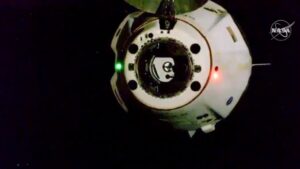Crew Dragon undocks from space station
By Jeff Foust

WASHINGTON — A SpaceX Crew Dragon spacecraft carrying two NASA astronauts on a test flight undocked from the International Space Station Aug. 1 ahead of a splashdown less than 24 hours later.
The Crew Dragon spacecraft, named Endeavour by the crew of the Demo-2 mission, undocked from the station’s Harmony module at 7:35 p.m. Eastern and started to maneuver away from the station. The undocking went according to plan and the spacecraft performed a series of thruster burns to move away from the station.
The spacecraft, with NASA astronauts Bob Behnken and Doug Hurley on board, is scheduled to splash down in the Gulf of Mexico off the coast from Pensacola, Florida, at 2:48 p.m. Eastern Aug. 2, about 50 minutes after a deorbit burn. A backup splashdown zone is off the coast from Panama City, Florida. A recovery ship will pull the capsule out of the water a short time after splashdown and the astronauts will then disembark.
The Demo-2 mission is the final test flight of the Crew Dragon spacecraft before it is certified for routine crew rotation missions to the station. It started with a launch May 30 on a SpaceX Falcon 9 from the Kennedy Space Center in Florida, followed by a docking May 31.
Getting back to Earth, though, will be the biggest test for the spacecraft. “The hardest part was getting us launched, but the most important part is bringing us home,” said Behnken during a farewell ceremony on the station Aug. 1.
During their two months on the station, Behnken and Hurley supported station activities such as research and maintenance. That included four spacewalks by Behnken with Chris Cassidy, who has been on the station since April with two Russian cosmonauts, to complete the replacement of batteries in the station’s power supply.
“We effectively tripled our ability of our work done, and with all three of us having been here before, it was in short order that were running at full steam and getting as many science objectives completed as we could,” Cassidy said during a July 31 media teleconference, adding that he appreciated “having buddies at the chow table” at the end of the day.
Astronauts also tested the spacecraft in orbit, confirming it was working as expected as well as checking how well four people — the complement of future Crew Dragon missions — can operate inside the spacecraft. “For the most part we’ve had pretty good luck with Endeavour as far as on-orbit testing is performed, just like it did for launch and rendezvous,” Hurley said at the July 31 event. “So we expect nothing different for the splashdown.”
“Splashdown is closer than the last time we were asked questions about it, but I still don’t feel nervous about it,” Behnken said.
That splashdown will be the first for a NASA crewed spacecraft since the Apollo spacecraft that participated in the Apollo-Soyuz Test Project splashed down in July 1975. About 20 SpaceX Dragon cargo missions splashed down over the past 10 years, as well as the Orion spacecraft on the Exploration Flight Test 1 mission in 2014, but none carried people.
Hurley said July 31 that he reviewed the reports from the astronauts who flew on the Skylab missions in the early 1970s, which splashed down after missions of durations similar to Demo-2. “The water landing portion is pretty challenging from a physiological standpoint,” he said, particularly after spending a couple months in weightlessness.
That includes seasickness. “We’ll both have the appropriate hardware ready should we start feeling a little bit sick on board while we’re in the vehicle after splashdown,” Behnken said, “but we know the team is going to get us pulled up and onboard the ship relatively quickly.”
Asked later what that “appropriate hardware” was, Hurley said it was bags like sickness bags on airliners, along with towels. “It certainly wouldn’t be the first time that that’s happened in a space vehicle. It would be the first time in this particular vehicle if we do.”
August 2, 2020 at 05:39AM
via SpaceNews read more...

Post a Comment